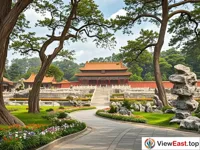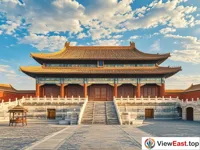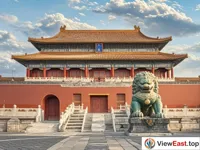







A. Scenic Spot Introduction
The Forbidden City: The Crown Jewel of Chinese Royal Culture
At the heart of China, in downtown Beijing, stands a palace that has witnessed the grandeur of the Ming and Qing dynasties — The Forbidden City. As a World Cultural Heritage site, it is renowned worldwide for its majestic architecture, rich history, and artistic value.
Historical Culture:
Also known as the Forbidden City, it served as the royal palace for the Ming and Qing dynasties for nearly 600 years. It was the residence of 24 emperors, and every brick and tile carries a heavy sense of history. The complex of buildings in the Forbidden City is not only vast in scale but also exquisite in detail, reflecting the pinnacle of ancient Chinese architectural art.
Natural Landscape:
The natural landscape of the Forbidden City is perfectly integrated with its architecture. The Imperial Garden, Qin'an Hall, and other locations within the palace are home to ancient trees, strange rocks, babbling brooks, and tranquil ponds, adding a touch of peace and elegance to this royal palace.
Cultural Characteristics:
The cultural characteristics of the Forbidden City are reflected in its unique court culture and various exhibitions. It houses a vast collection of ancient art and cultural relics, such as porcelain, calligraphy, paintings, and clocks, each piece a gem of traditional Chinese culture. Additionally, the Forbidden City often hosts cultural activities and exhibitions, allowing visitors to gain a deeper understanding of China's history and culture.
Unique Experiences:
At the Forbidden City, you can experience the charm of royal culture firsthand. Visit the Hall of Supreme Harmony, the Palace of Heavenly Purity, and other significant palaces to feel the emperor's majesty; stroll through the Imperial Garden to experience the exquisiteness of royal gardens; view various exhibitions to delve deeper into Chinese art and history. Moreover, you can purchase unique souvenirs from the Forbidden City, such as the "I know" tape, as a precious memory of your trip.
Stories and Metaphors:
The Forbidden City is like a thick historical book, with each page recording the glory and vicissitudes of the Chinese royal family. Each palace and every collection seems to tell a story about power, art, and culture. As you walk through this complex, you'll feel as if you've traveled through time and returned to that glorious dynasty.
B. Travel Suggestions
Transportation Routes:
Starting from major cities in China, you can travel to Beijing by plane or high-speed train. Beijing has multiple airports and train stations, making it easily accessible. Upon arrival in Beijing, you can take the subway line 1 to Tiananmen East Station, and the Forbidden City is within walking distance.
Tourism Convenience:
The Forbidden City is located in the heart of Beijing, and the surrounding tourism facilities are very well-developed. The Palace Museum offers guided services in multiple languages and a wealth of cultural activities and exhibitions for visitors to choose from.
Accommodation, Food, and Safety:
Beijing has good public safety, and tourists can enjoy their visit with peace of mind. There are various types of hotels and restaurants near the Forbidden City, where you can taste authentic Beijing roast duck, Zhajiang noodles, and other local specialties.
Specialty Cuisine:
In Beijing, you can also enjoy authentic local snacks, such as Douzhir, Lu Dagun, etc., which are indispensable parts of experiencing the local culture.